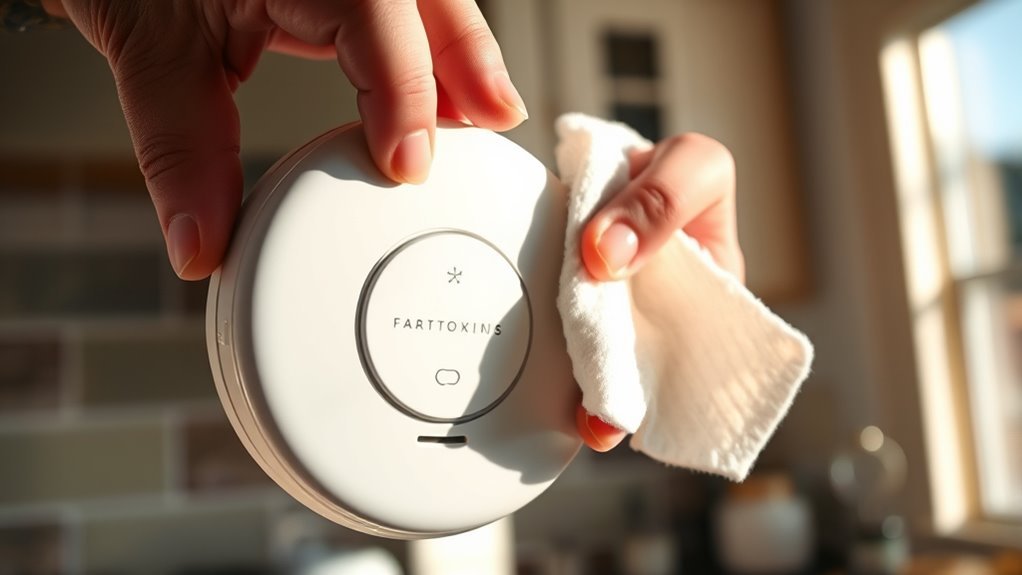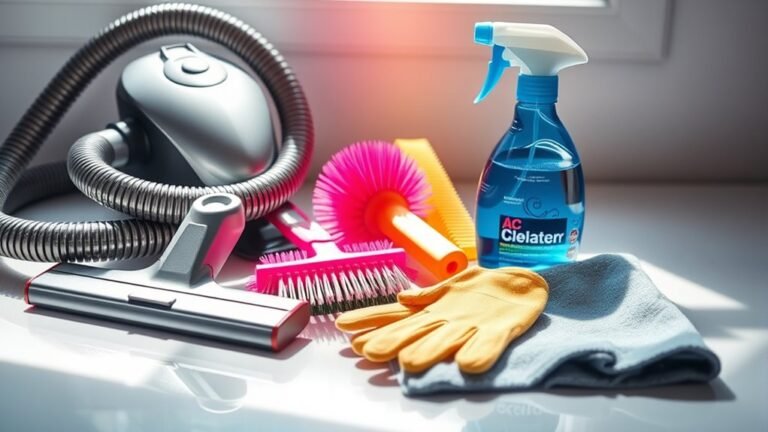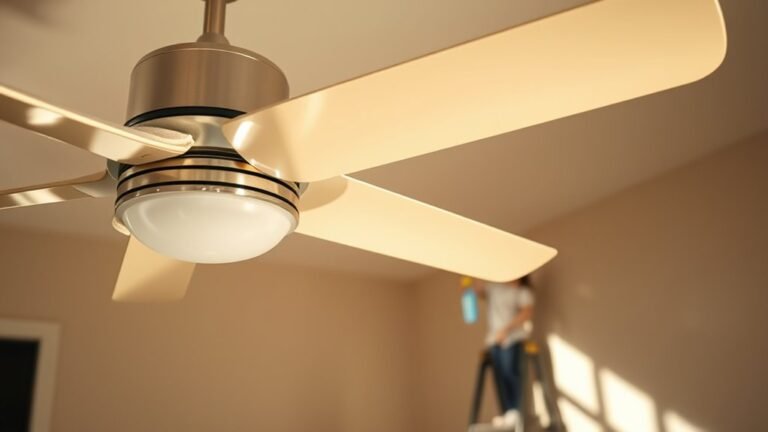Cleaning and Maintaining Carbon Monoxide Detectors
You should clean your carbon monoxide detector every six months using a soft cloth and mild soap to prevent dust buildup that can impair its function. Always power off and remove the device before cleaning, avoid harsh chemicals, and gently clear vents with compressed air. Test your detector monthly and replace batteries as needed. Detectors last 5 to 7 years, so monitor for signs of wear. Proper care guarantees your safety—there’s more to know about installation and testing for full protection.
Understanding the Importance of Carbon Monoxide Detectors
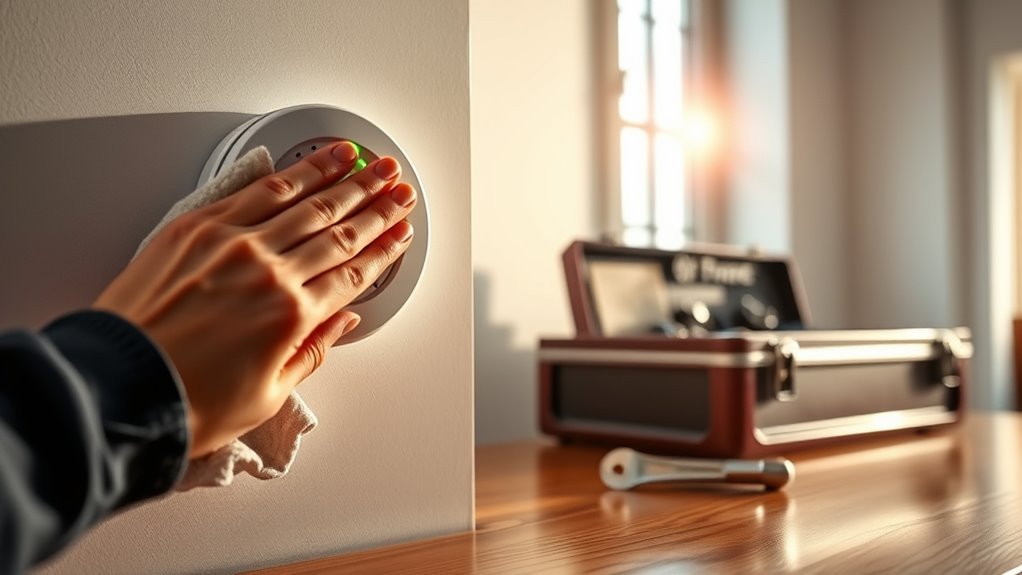
Although you might not think about it every day, carbon monoxide detectors play an essential role in keeping you and your family safe. You deserve the freedom to live without fear of invisible dangers, and these devices help protect you from carbon monoxide sources like faulty heaters, gas stoves, or blocked vents. Understanding their importance means recognizing that these detectors aren’t just gadgets—they’re your first line of defense. But remember, every detector has a limited detector lifespan, typically 5 to 7 years, after which its sensing ability fades. Staying informed about this helps you maintain your independence and security, ensuring your home stays safe. Taking responsibility for your detector’s health means you’re actively choosing freedom from unseen hazards.
How Often Should You Clean Your Carbon Monoxide Detector?
You should clean your carbon monoxide detector at least once every six months to keep it working properly. If you notice dust buildup or it’s not responding as it should, it’s a good sign it needs cleaning sooner. Regular checks help guarantee your safety by keeping the detector in top shape.
Recommended Cleaning Frequency
Since carbon monoxide detectors play a crucial role in your safety, cleaning them regularly is essential to guarantee they function properly. You should follow cleaning schedules recommended by the manufacturer, typically every six months, to keep your detector free from dust and debris that could impair its sensors. Sticking to this routine helps extend your detector’s lifespan and guarantees it reacts promptly during emergencies. If your environment is dustier or you have pets, you might want to clean it more often. Remember, regular maintenance isn’t just about cleanliness—it’s about preserving your independence and peace of mind knowing your home is protected. By committing to a consistent cleaning schedule, you maintain both your detector’s reliability and your freedom to live safely without constant worry.
Signs It Needs Cleaning
Keeping a regular cleaning schedule is key, but knowing when your carbon monoxide detector actually needs attention can save you trouble. Pay close attention to cleaning signs and maintenance indicators that signal it’s time for a refresh. Ignoring these could limit your freedom to feel safe at home.
| Cleaning Sign | What It Means for You |
|---|---|
| Dust buildup on the surface | Detector may not sense properly |
| Frequent false alarms | Sensor might be dirty or faulty |
| Reduced sensitivity | Needs thorough cleaning soon |
| Unresponsive test button | Possible internal issues |
| Old detector (over 5 years) | Time to replace, not just clean |
Trust these maintenance indicators to keep your detector reliable and your freedom intact.
Tools Needed for Cleaning Carbon Monoxide Detectors
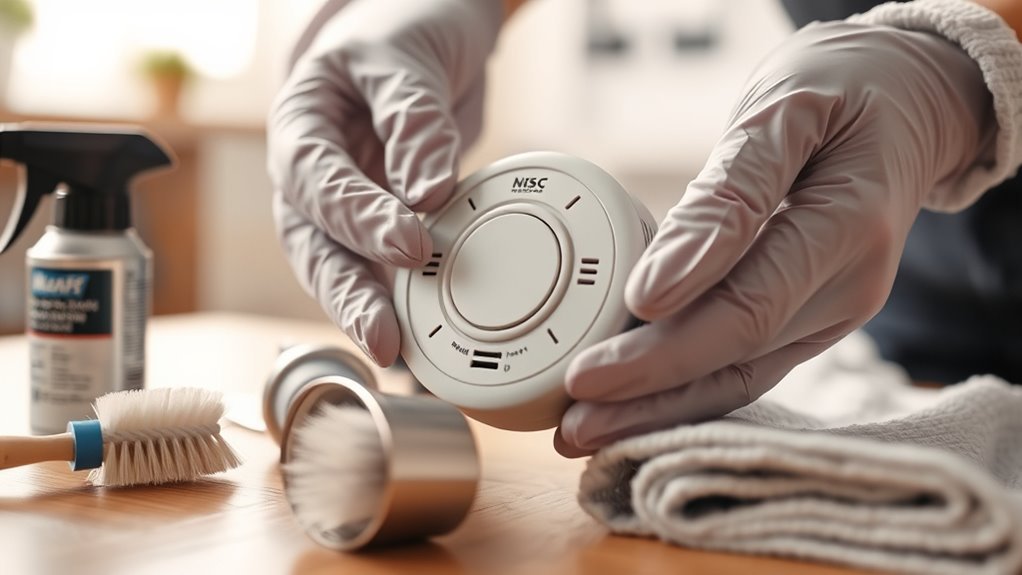
A few essential tools will make cleaning your carbon monoxide detector straightforward and safe. You’ll want basic cleaning supplies like a soft cloth and mild soap to gently wipe away dust and grime without damaging sensitive parts. A small, soft-bristled brush helps reach tight spaces where dust loves to hide. For maintenance tools, having a screwdriver handy lets you open the detector’s casing if needed. Avoid harsh chemicals or abrasive materials—they can interfere with the detector’s function. Also, a can of compressed air is useful for blowing out stubborn dust without contact, keeping your freedom intact by ensuring your detector stays reliable. With these tools ready, you’re set to keep your detector clean, functional, and your environment safe.
Step-by-Step Guide to Cleaning Your Detector
Now that you have your tools ready, let’s go through the steps to clean your carbon monoxide detector properly. You’ll want to focus on removing dust gently without damaging the sensor. Following these tips will help keep your detector working accurately and safely.
Dust Removal Techniques
Before you start cleaning your carbon monoxide detector, make certain it’s powered off and removed from its mounting. Dust accumulation can hinder its performance, so tackling it with the right cleaning methods is key. Start by gently wiping the exterior with a soft, dry cloth to remove loose dust. Then, use a can of compressed air to blow out dust from vents and crevices—this prevents particles from settling inside. Avoid using water or harsh chemicals, as they can damage the detector. If stubborn dust remains, a soft brush can help loosen it without risking harm. By regularly applying these dust removal techniques, you guarantee your detector stays clear and reliable, giving you the freedom to breathe easy without worrying about hidden buildup compromising safety.
Sensor Care Tips
Taking care of your carbon monoxide detector’s sensor is essential for ensuring accurate readings. To maintain peak sensor sensitivity and extend the sensor lifespan, follow these simple steps:
- Handle with care: Avoid touching the sensor directly; oils and dirt from your fingers can reduce sensitivity and shorten its lifespan.
- Regular cleaning: Use a soft brush or compressed air to gently remove dust and debris without damaging the sensor components.
- Avoid harsh chemicals: Never use cleaners or solvents on the sensor, as they can degrade sensor materials and impact performance.
Common Mistakes to Avoid When Maintaining Your Detector
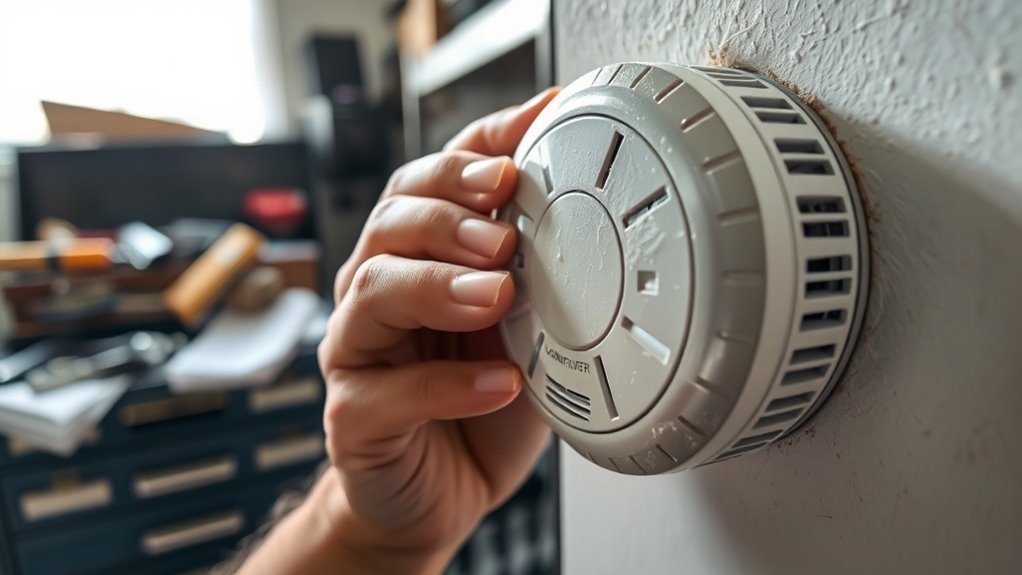
Although maintaining your carbon monoxide detector is essential, many people make avoidable mistakes that can reduce its effectiveness. One common error is neglecting the detector battery; relying on old or weak batteries can cause your device to fail when you need it most. Don’t wait for the low-battery alert—replace batteries regularly to keep your freedom intact and your home safe. Another frequent mistake involves installation errors. Placing the detector too close to fuel-burning appliances or in humid areas can lead to false alarms or missed detections. Make certain you follow manufacturer guidelines for proper placement, avoiding corners or blocked vents. By steering clear of these pitfalls, you guarantee your detector stays reliable, giving you peace of mind without unnecessary worries.
How to Test Your Carbon Monoxide Detector for Proper Function
Maintaining your carbon monoxide detector properly means more than just avoiding common mistakes—it also requires regular testing to guarantee it’s working correctly. You want to be sure your detector is ready to protect your freedom and safety at all times.
Proper maintenance of your carbon monoxide detector includes regular testing to ensure it’s always ready to protect you.
Here are three simple testing methods to follow:
- Press the test button on your detector; it should emit a loud alarm immediately.
- Replace the batteries and repeat the test to confirm power reliability.
- Use a CO test kit designed for detectors to simulate carbon monoxide presence safely.
When to Replace Your Carbon Monoxide Detector
How do you know when it’s time to replace your carbon monoxide detector? Pay close attention to replacement indicators and lifespan considerations. Most detectors last 5 to 7 years, after which their sensors degrade, risking your safety and freedom.
| Indicator | What to Check | Action Needed |
|---|---|---|
| Expiration Date | Printed on device or manual | Replace immediately |
| Frequent False Alarms | Unexplained beeping | Consider replacement |
| Failure to Test Alarm | No sound during testing | Replace without delay |
Don’t wait for an emergency to lose protection. Trust these signs, and swap out your detector promptly to maintain your independence and peace of mind.
Tips for Proper Placement and Installation of Detectors
Since carbon monoxide is colorless and odorless, placing your detectors correctly is crucial to confirm they can alert you promptly. To guarantee freedom from worry, consider these tips for proper placement and installation:
Proper placement of carbon monoxide detectors ensures timely alerts and peace of mind.
- Installation location: Choose locations near sleeping areas and on every level of your home, avoiding dead air spaces like corners or near windows and vents.
- Detector height: Install detectors at least 5 feet above the floor, as carbon monoxide mixes evenly with air but tends to be slightly heavier.
- Avoid obstructions: Keep detectors away from appliances or areas with excessive humidity, dust, or direct sunlight to maintain sensitivity.
Following these guidelines confirms your detectors work effectively, giving you peace of mind and freedom to live safely.
Frequently Asked Questions
Can Carbon Monoxide Detectors Be Interconnected for Better Home Safety?
You can definitely use interconnected systems for better home safety. When one carbon monoxide detector senses danger, all alarms go off, so you’re instantly alerted no matter where you are in your home. This setup gives you freedom to move around without worrying about missing a critical alert. Interconnected detectors enhance your peace of mind, making your living space safer and letting you live freely without constant safety concerns.
Are There Smart Carbon Monoxide Detectors With App Notifications?
Sure, because who doesn’t want their carbon monoxide detector sending them a text like it’s your overbearing friend? But seriously, smart carbon monoxide detectors with app integration do exist, giving you freedom from constant worry. With these smart features, you get instant notifications on your phone if danger strikes, letting you act fast no matter where you are. It’s safety that fits your lifestyle, not the other way around.
How Do Temperature Changes Affect Carbon Monoxide Detector Performance?
You’ll find that temperature fluctuations can impact your carbon monoxide detector’s sensitivity. When temperatures swing dramatically, the sensor might become less accurate, either delaying alarms or triggering false ones. Since you value freedom and reliability, it’s important to place your detector in areas with stable temperatures to keep it working smoothly. This way, you can trust it to alert you precisely when needed, without unnecessary interruptions.
Can Pets Trigger False Alarms on Carbon Monoxide Detectors?
You move, you breathe, you live freely—so do your pets. But can pet behaviors trigger false alarms on carbon monoxide detectors? Generally, no. These detectors are designed with specific sensor technology, and their sensitivity targets carbon monoxide, not fur or movement. However, excessive pet dander or close contact might occasionally cause minor interference. So, while pets won’t usually set off false alarms, keeping detectors clean guarantees they work with the freedom you both enjoy.
What Is the Difference Between Carbon Monoxide Detectors and Smoke Detectors?
You might wonder what sets a carbon monoxide detector apart from a smoke detector. Well, carbon monoxide detectors sense invisible, odorless gas that can be deadly, while smoke detectors pick up smoke particles from fires. Both protect your freedom by alerting you to danger, but they focus on different threats. To stay safe and independent, it’s smart to have both types installed in your home.
